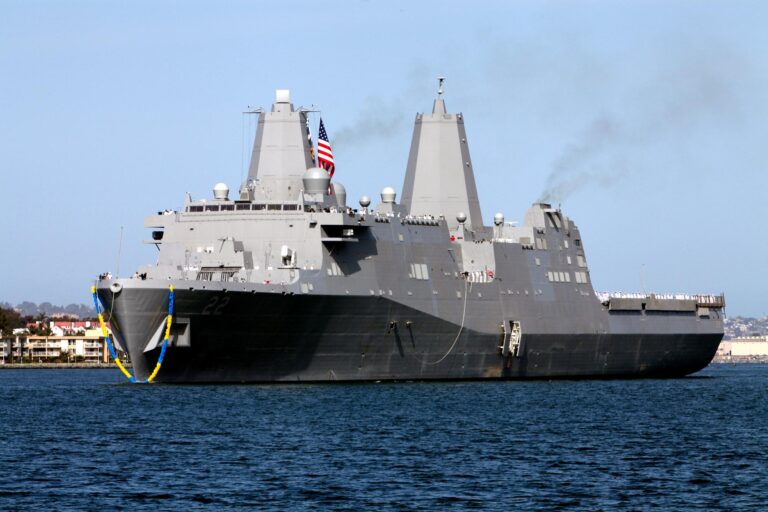The USS San Diego and USS Rushmore have arrived in Sydney, joining the USS America as part of a significant naval presence in the region, according to reports from the Defense Visual Information Distribution Service (DVIDS). This deployment underscores the ongoing cooperation between the United States and Australian naval forces, enhancing joint readiness and maritime security in the Indo-Pacific. The three vessels’ coordinated operations in Sydney highlight strategic partnerships amid evolving regional dynamics.
USS San Diego and USS Rushmore Arrive in Sydney to Bolster Regional Presence
The arrival of the USS San Diego (LPD-22) and USS Rushmore (LSD-47) in Sydney marks a strategic reinforcement of U.S. Naval capabilities in the Indo-Pacific region. Docking alongside the USS America (LHA-6), this formidable trio enhances joint operational readiness and strengthens the U.S.-Australia alliance. These amphibious vessels bring advanced amphibious assault, transport, and support capabilities designed to ensure maritime security and promote stability across the region.
Key operational objectives include:
- Joint training exercises with Australian Defence Forces
- Humanitarian assistance and disaster relief preparedness
- Regional maritime domain awareness enhancement
- Strengthening force projection and rapid deployment
These efforts underscore commitment to a free and open Indo-Pacific, ensuring seamless collaboration among allied navies and boosting security partnerships throughout the Pacific theater.
Strategic Significance of USS America’s Deployment in Indo-Pacific Operations
The deployment of the USS America alongside USS San Diego and USS Rushmore in the Indo-Pacific region marks a deliberate strategic step aimed at bolstering U.S. naval presence and readiness in a theater of increasing geopolitical importance. By operating as a cohesive unit, these amphibious assault ships significantly enhance the U.S. Navy’s ability to project power, respond swiftly to emerging threats, and support regional allies. Their presence underscores commitments to maintaining freedom of navigation and deterring aggression in contested waters, including key areas such as the South China Sea and Taiwan Strait.
Key strategic advantages include:
- Force Multiplication: Integration of aviation, amphibious, and expeditionary capabilities provides unrivaled operational flexibility.
- Enhanced Interoperability: Joint exercises with Indo-Pacific partners strengthen alliances and improve coordinated response efforts.
- Rapid Humanitarian Assistance: Ability to deploy disaster relief and medical aid swiftly within the region.
| Ship | Primary Capability | Operational Focus |
|---|---|---|
| USS America (LHA-6) | Amphibious Assault & Aviation | Power Projection & Air Operations |
| USS San Diego (LPD-22) | Transport & Deployment of Marines | Expeditionary Warfare Support |
| USS Rushmore (LSD-47) | Dock Landing & Amphibious Transport | Force Mobility & Logistics |
Enhanced Joint Training Exercises Highlight Interoperability Among Allied Forces
Recent multinational exercises involving USS San Diego, USS Rushmore, and USS America have demonstrated significant advancements in allied operational synergy. These maneuvers focused on complex amphibious assault coordination, joint logistics support, and real-time communication interoperability, marking a milestone in combined force capabilities. Participating units showcased refined tactical flexibility, enabling seamless integration during dynamic combat scenarios across multiple maritime domains.
Key highlights from the training include:
- Simultaneous amphibious landings coordinated between surface vessels and embarked Marine units
- Enhanced data sharing protocols ensuring secure, instantaneous communication
- Cross-deck flight operations expanding air support versatility across allied ships
- Joint medical evacuation drills ensuring rapid casualty response
| Exercise Element | Participating Units | Outcome |
|---|---|---|
| Amphibious Assault | USS San Diego, USS America | Flawless synchronization of landing craft deployment |
| Communication Drills | All Ships | Zero communication delays during operations |
| Medical Evacuation | USS Rushmore, Allied Medical Teams | Rapid casualty transfer within 30 minutes |
Recommendations for Strengthening Maritime Security Cooperation in the Pacific
Enhancing maritime security in the Pacific requires a comprehensive and collaborative approach among regional partners. Strengthening joint naval exercises, increasing intelligence sharing, and implementing unified communication protocols will ensure improved situational awareness and rapid responses to emerging threats. Fostering interoperability between the USS San Diego, USS Rushmore, USS America, and allied forces is critical for projecting stability across vital sea lanes.
Key recommendations to bolster cooperation include:
- Regular Multinational Training: Conduct combined drills focusing on search and rescue, anti-piracy, and humanitarian assistance missions.
- Shared Resource Development: Invest in joint infrastructure upgrades to support extended deployments and maintenance in Pacific ports.
- Advanced Technology Integration: Promote the exchange of cutting-edge maritime surveillance systems and secure communication platforms.
| Category | Action | Expected Outcome |
|---|---|---|
| Training | Annual multinational naval exercises | Stronger operational coordination |
| Infrastructure | Upgrade Pacific naval bases | Enhanced logistical support |
| Technology | Integrate shared maritime sensors | Improved maritime domain awareness |
Closing Remarks
The arrival of USS San Diego and USS Rushmore alongside USS America in Sydney marks a significant moment in ongoing naval cooperation and strategic presence in the Indo-Pacific region. These deployments underscore the commitment of the U.S. Navy to strengthening alliances and enhancing regional security through joint operations and port visits. As these vessels continue their missions, their presence in Sydney serves as a tangible reminder of the enduring partnership between the United States and Australia, fostering stability and readiness amid evolving geopolitical dynamics.







